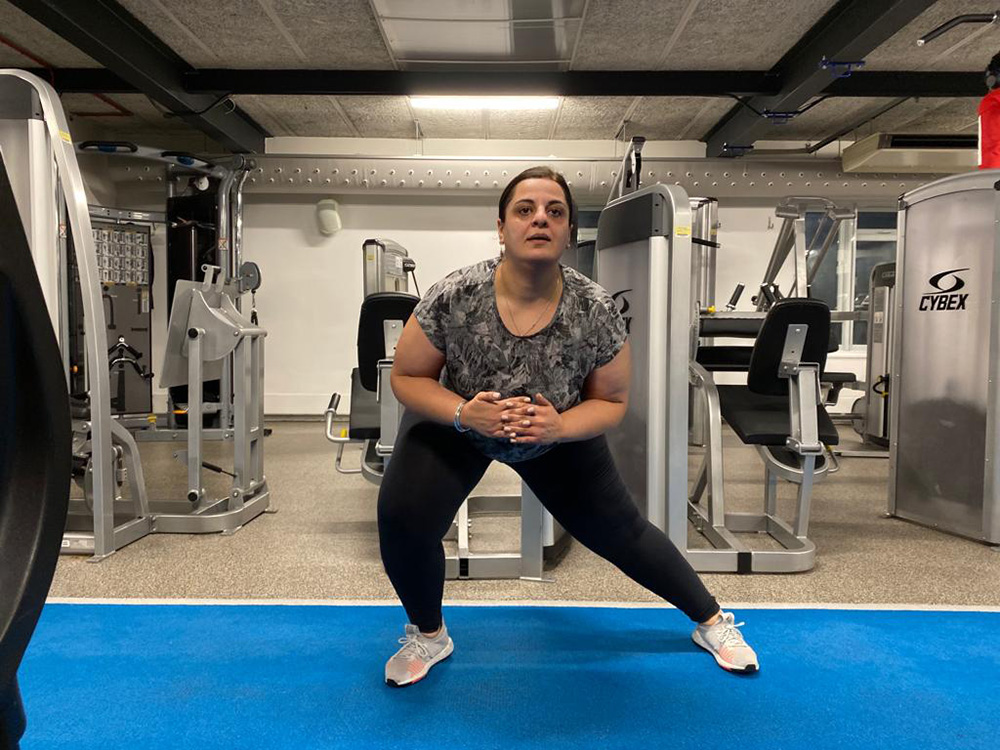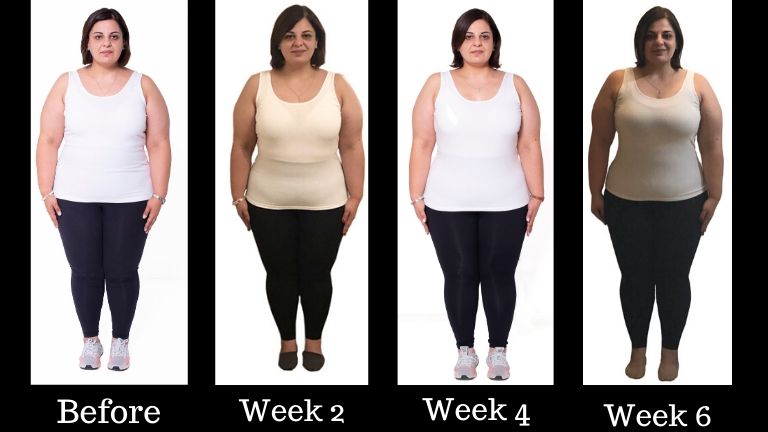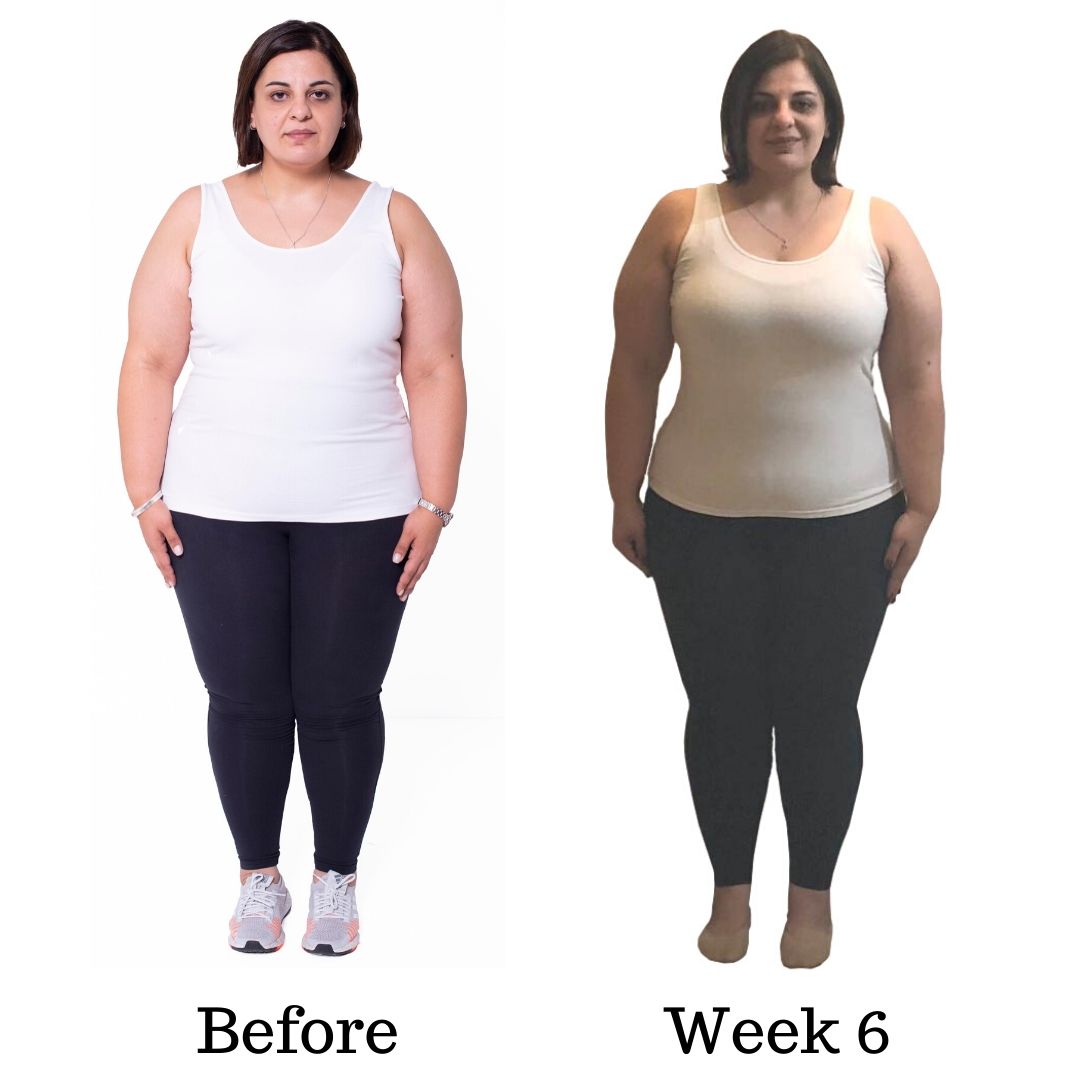Dina is half way through her 10 week body transformation and has now lost a total of 6.8 kilos, that’s over a stone in just six weeks. This week, Dina explains how you can break a weight loss plateau just like she did
All I can say is – what a difference a week can make.
Last week I revealed that I had lost 0.6kgs (just under 1.5 pounds), which totally meant I was on track for losing one to two pounds a week, but it could also be considered a plateau or the start of one when comparing it to the weight I had lost in previous weeks.
But this week? I lost a whole kilo! That’s over two pounds in one week. So it’s safe to say I have broken through the possible plateau phase.
| Before | End of Week 1 | End of Week 2 | End of Week 3 | End of Week 4 | End of Week 5 | |
| Weight (kg) | 120 | 116 | 115.5 | 114.8 | 114.2 | 113.2 |
| Chest (centimetres) | 118 | 116 | 115.5 | 112 | 110 | 109 |
| Waist (centimetres) | 115 | 114 | 113 | 112 | 108 | 100 |
| Hips (centimetres) | 141 | 139 | 137 | 135 | 132 | 131 |
| Total weight-loss | N/A | 4 | 4.5 | 5.2 | 5.8 | 6.7 |
What causes a weight loss plateau?
A weight loss plateau is when you stop losing weight or your rate of weight loss slows down considerably. According to experts, hitting a plateau is nothing unusual. As your weight drops and your body composition changes, so do your nutritional and exercise needs.
Co-founder of Your Body Programme, Terry Fairclough says that, ‘a plateau may occur when your body adapts to your diet and exercise routine, quite simply your body becomes more efficient at doing what it has become used to’.
It can happen to anyone, from runners to athletes to dieters. Essentially the story goes, you’re working hard to meet your weight loss goals when suddenly (and oh so annoyingly), the number on the scales refuses to change or God forbid, starts to creep back in the wrong direction because your body has simply gotten used to your healthy routine – it so doesn’t seem fair, right?
This almost always occurs after you have already lost some weight. The initial weight loss comes from the first reaction to a healthy routine, but then it starts to slow down or stop completely.
This can be very discouraging, especially when you are working hard but seeing no results. For many, a weight loss plateau can last days or even months. This is often what causes people to give up on their weight loss efforts.
‘People always get very good gains and results after their first week or two of a weight loss programme,’ says Fairclough.
‘After this time, weight loss can start to level off. Often people go to the gym for years and years and continue to do the same sort of repetitive exercise. This results in their bodies never actually changing’.
Another reason for a plateau is that your body will naturally try to maintain a certain weight where it is at its most comfortable. Therefore, if you find yourself stuck at the same weight all over again, your body may have resorted back to its comfort zone, this is when you need to step it up a gear.
So, how do you breakthrough a plateau?
When on a weight loss journey, it is an ongoing journey – you won’t just wake up one day and be in shape for the rest of your life, it takes continuous hard work and effort.
If you have lost some weight and are now looking to lose more weight, your body may now need fewer calories or more physical activity to sustain your lower weight or to lose more weight.
‘You have to keep shocking the body with your exercise routine and diet routine, preferably every month,’ suggests Fairclough.
This is when you need to be honest with yourself and ask yourself these sort of questions:
- Am I doing something wrong?
- Has anything changed in your diet and fitness plan since you started?
- Have your portion sizes crept back up?
- Have you missed a few too many exercise sessions?
- Are you trying as hard during those sessions?
- Have you indulged in any high calorie foods one too many times?
If you have reached a plateau stage and have answered yes to any of those questions or just need to push your body even harder to get the results you want, here’s what you need to do to break though your plateau…
#1 It’s time to lessen your calorie intake
Firstly, you need to look at lowering your calories, but not by too much. ‘It is possible to shock and challenge the body through your diet,’ says Fairclough.
When I started this 10-week transformation, Terry wanted me to track what I would normally eat in a day, so that he could lessen my daily calorie intake to create a calorie deficit and shock to my body, but not so that it caused too much of a shock.
We worked out that I was eating around 2,500 calories a day. So, Terry suggested that I lower my daily calorie intake to 2,000 for the first four weeks of the transformation. This was determined after looking at my height, weight, age and activity level.
The reason for dropping my calorie intake only slightly was so that we can trick the body into thinking that this amount of calories is the new norm, remember gradual weight loss is far more beneficial than sudden dramatic weight loss.
Terry asked me to drop my daily calorie intake again, this time from 2,000 to 1,750 calories.
The last thing Terry wanted to do was shock my body too much by going from 2,500 calories to 1,500 calories. This would have caused my body to go into starvation mode which from a metabolic point of view would have messed up my metabolism by slowing it down significantly.
But after four weeks it was time for another slight shock diet wise. Terry asked me to drop my daily calorie intake again, this time from 2,000 to 1,750 calories.
Additionally, as you lose weight, your metabolism can drop because your body requires less calories and energy to fuel the smaller version of yourself.
‘The calorie intake you initially had when you began your weight loss journey will need to be changed and adjusted to match your new body’s current needs, if further weight loss is your goal,’ explains Fairclough.
So take a look at your calories and minus them by 250 or 500 and see if this makes a difference to your weight loss results.
#2 Watch your portion sizes and keep a food journal
Could you be slacking off a bit on the strict calorie rule? You’ve established that you need to lower your calories, now you need to make sure that you are actually consuming the right amount of calories by checking your portion sizes.
It’s time to get your measuring cups out and get religious all over again with MyFitnessPal. Underestimating portion sizes and calorie amount is a common diet mistake. Read more about that back in my first transformation week.
‘One important reason that I do suggest having a regular intake of the same macros or calories everyday when on a weight loss journey is because the repetition means you are very aware of exactly what and how much you are eating on a daily basis.
‘This makes it far easier to make a change to your diet when you need to, because you know exactly what and how much you are consuming.
‘But if you are eating loads of different food a day at different quantities, with more calories one day and less carbs the other, it can be really hard to change your diet where you need to. Consistency here is key in my eyes’.
If you really aren’t about religiously counting calories on an app or weighing out your food to the very last gram and to be honest not all of us do have time for that, if that is the case, why not keep a food journal instead (or as well as)?
Keeping a food journal can be a great motivator, and it will help you to be aware of exactly what and how much you are eating, without being too obsessive.
But be honest with yourself, even if you have one crisp from a friend’s packet or one bite of a cookie – be sure to write it down.
The calories you’ll eat from an extra bite here or a little snack there WILL count. Resist the urge to snack but if you do, write it down and remember you have done so, even something as tiny as this could be the reason you have stopped seeing results.
#3 Make sure you are sticking to your cardio sessions and it’s time to UP the intensity
In week one, I learnt that my two to three cardio sessions per week would be in the form of high intensity interval training, also known as HIIT training.
This type of high intensity training will help me to lose weight by increasing the output of my mitochondria as well as the number of mitochondria within our cells – these are the powerhouses in our cells where calories are burned to produce and provide us with the energy we need.
The better the output of your mitochondria from exercise, the more fat you will burn.
High intensity training will also have the effect of increasing my metabolism, which will result in me burning more calories throughout the day and whilst I sleep – this is known as the EPOC (excessive post-exercise oxygen consumption), also known as the afterburn effect.
Terry also explained that I need to keep up the frequency of my training sessions, so that I keep my metabolism up and firing and therefore burning more calories, that means having no more than one consecutive day off.
After week four, Terry informed me that my cardio sessions would be made slightly harder than before. I was worries he was about to tell me I had to do more than three cardio session a week which would have been a struggle, but instead he said that I needed to increase the interval times.
For example, for the first four weeks I would exercise at a high intensity for15 seconds and then rest for 45 seconds, now though, I will be exercising at a high intensity for 20 seconds and resting for 40 seconds.
This is the cardio workout I do 2 to 3 times per week:
The cardio workout is split into three sections: Intervals, lactic acid removal phase, followed by a repeat of the intervals. Here’s more detail:
1. A five minute warm up
2. 10 intervals of 20 second sprinting at 100 per cent intensity (that’s pushing as hard as you possibly can for 15 seconds), followed then by 40 seconds of resting. This can be done on any of the cardio equipment such as a treadmill, cross-trainer, bike, rower and more.
3.10 minute ‘lactic acid removal phase’ – a workout on the same or different cardio machine at a consistent pace but to the maximum intensity you can possibly manage. This means you should not be able to hold a conversation, you should be sweaty and out of breath, yet able to sustain the exercise for the required length of time (ten minutes).
4. 10 minutes of the first intervals again – ten x 20 seconds again, same as the first round. You can also combine equipment rather than performing the entire workout on just one machine – mix things up a bit.
Cardio Concept:
| Number of Intervals | Sprints | Rest |
| 10 | 20 sec | 40 sec |
| Lactic Acid Removal Phase – 12 minutes | ||
| 10 | 20 sec | 40 sec |
| Total Workout Time – 32 minutes | ||
This video shows my cardio workout:
#4 Change up your resistance training too
It’s also time to look at making your resistance workouts harder. Remember the more muscle you build and have the more calories you will burn. ‘Muscle tissue is more metabolically active and will help burn more calories,’ adds Fairclough.
In week four I spoke about compound exercises and why they are particular effective when it comes to body transformations and fat loss.
Compound exercises are big movements that use lots of muscles, such as glutes, hamstrings, quads and core. They work several muscles or muscle groups at one time.
For example, a squat uses a number of muscles in the core, lower back and lower body including the quadriceps, hamstrings, calves and glutes – see, many different muscles being worked in one exercise. Weighted lunges, deadlifts and even push ups are compound movements for the same reason, they use a number of muscles.
Some other benefits of compound movements include: they usually burn more calories, speed up your metabolism, they simulate real-world exercises and activities and are therefore functional movements that allow you to get a full body workout, they keep your heart rate up, providing cardiovascular benefits too.



This month my resistance workouts have still consisted of these compound movements, but my new concepts is 45 seconds of the same exercise with just 15 seconds of rest between each of the six or seven exercises.
Decreasing my rest time and upping my exercise time keeps my heart rate sky high, which means more calories being burnt and bigger weight loss results.
Exercise Concept – 45’s
This programme consists of six or seven exercises performed consecutively for 45 seconds each with 15 seconds to move into the next exercise. This constitutes a set. Then, rest for three minutes in between each set. Perform four sets in total.
Remember to keep the weights heavy and challenging to elicit the correct hormonal and metabolic response.
| Exercises in each set | 6 |
| Time of each exercise | 45 sec |
| Sets | 4 |
| Rest between sets | 3 min |
This video shows a typical resistance training session in my second month:
Six different exercises, 45 seconds each exercise with 15 seconds rest between each exercise. This I did four times.
Squat jumps 45, seconds. Rest, 15 seconds,
Push ups, 45 seconds. Rest, 15 seconds,
Kettlebell deadlifts, 45 seconds. Rest, 15 seconds,
Mountain climbers, 45 seconds. Rest, 15 seconds,
Alternating lunges, 45 seconds. Rest, 15 seconds,
Sit ups, 45 seconds. Rest, 3 minutes.
Repeat three more times.
#5 Remember why you want to lose weight
Lastly, when you reach a plateau and want to give up remind yourself of why you wanted to start this weight loss journey in the first place. Reaffirm your commitment to the programme you are on and regain the determination you had when you began your journey.
Can you remember what motivated you to start your transformation journey? Well I do.
Over the last two years, my weight gain has been so rapid, I’ve started to worry that there was no way out. I wanted to get fit and healthy before my 40th birthday in four years’ time.
I also have two nephews who I adore, I want to be active for them and be able to have the energy to play with them. Plus, it would be amazing if I were able to get into some of my dresses from seven years ago that are now two sizes too small.
So there’s my motivation – to get fit before 40, not just for me, but my family too – that seems like a good reason to not give up and keep going.
I also thought I deserved a reward for all my hard work this week. Do you know what i did? I went shopping and bought a dress in a smaller size than I have bought in years. I cant suggest this enough if you are looking for some extra motivation.
Come back every week to read Dina’s week by week diary of her weight loss transformation with Terry and Luisa from Your Body Programme, with tips and advice from the experts.
Your Body Programme was founded by Terry Fairclough and Luisa Valenti.
The idea came about after Terry and Luisa saw other personal trainers regularly offering the same generic plan to every client, regardless of gender, goal or body type.
Terry and Luisa are passionate about the need to train everyone as an individual to achieve maximum results, and therefore don’t use a one-size-fits-all approach.
Relevant Healthista Content:
I did a body transformation and lost 11 inches – this is what REALLY works for fat loss
30 day transformation using a low calorie diet
Healthista Content You May Also Like:
7 best Golden Globe body transformations
9 diet rules this celebrity personal trainer lives by
Body transformation week one – operation FAT LOSS
5 fat loss supplements proven by science
Like this article? Sign up to our newsletter to get more articles like this delivered straight to your inbox.


























































